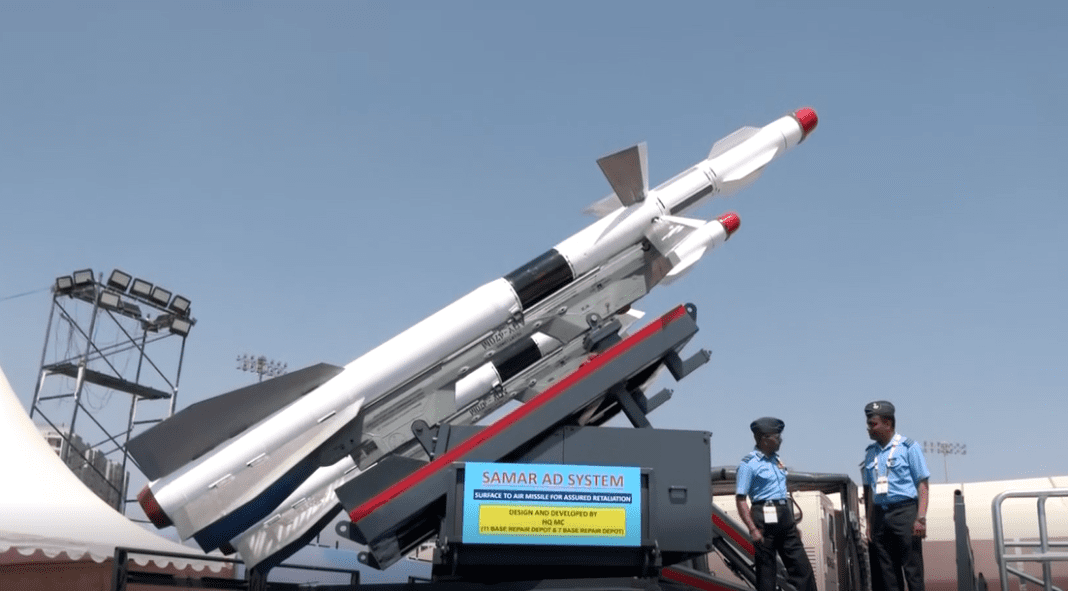India is set to test-fire a new air defence system, SAMAR 2, before the end of the year. This locally produced system, with a range of nearly 30 km. It is a significant step in strengthening the country’s air defence capabilities. The Indian Air Force (IAF) has led the development of SAMAR 2. And is working closely with two industry partners.
SAMAR 1: The Predecessor
After SAMAR 1 was successfully introduced into the IAF, the SAMAR 2 system was developed. The first variant, SAMAR 1, has a range of 8 km and has proved to be effective. It was recently showcased at the International Defence Aviation Exposition, held alongside the Tarang Shakti 2024 exercise. This exercise is the largest multilateral air combat drill hosted by India. It featured ten foreign air forces and 18 countries participating as observers.
Leveraging Existing Technology
Both SAMAR systems use Russian-origin air-to-air missiles repurposed for a surface-to-air role. The R-73E missile equips SAMAR 1, while the upcoming SAMAR 2 will use the R-27 missile. There is a special issue in converting these missiles, which have outlived their usefulness for aerial applications. It also represents an innovative use of existing technology. By turning potential waste into a valuable defence asset.
Capabilities of SAMAR 2
SAMAR 2 neutralises various aerial threats, including fighter jets, helicopters, and unmanned aerial vehicles (UAVs). This flexibility makes it a crucial addition to India’s air defence network. The new system’s extended range of nearly 30 km allows for greater coverage. And has improved response times in defending against potential threats.
DRDO’s Role in Air Defence
India is also making strides in developing more advanced air defence systems. The Defence Research and Development Organisation (DRDO) is working on Project Kusha. It is an indigenous long-range surface-to-air missile system. The system will have a maximum range of 350 km and should become operational within the next four to five years.
DRDO has also developed the Indigenous Very Short-Range Air Defence System (VSHORADS). This system handles low-altitude aerial threats at short ranges and provides a versatile and mobile defence solution.
India’s Current Air Defence Arsenal
India’s air defence arsenal has a mix of local and foreign weapons. The S-400 system from Russia is one of the most advanced in the world. India also uses medium-range missiles made with help from Israel.
Other important systems include the Israeli SpyDer and several older Soviet systems like Pechora, OSA-AK, Tunguska, Strela, and Shilka. The country also has Zu-23-2B anti-aircraft guns, upgraded L-70 guns (originally made by the Swedish company Bofors), and Igla man-portable air defence systems (MANPADS).
The Future of Indian Air Defence
The development of SAMAR 2 and other indigenous systems marks a significant step forward for India’s air defence capabilities. By focusing on locally produced systems, India is not only enhancing its military strength but also reducing its reliance on foreign suppliers.
The upcoming test-firing of SAMAR 2 will be a crucial moment for the IAF and its partners. If successful, it will pave the way for the system’s induction into active service, providing India with a more robust and flexible air defence network.
In the coming years, as projects like Kusha and VSHORADS come to fruition, India will continue to build a comprehensive and self-reliant air defence strategy. This approach ensures that the country remains well-equipped to defend its airspace against a wide range of threats.

